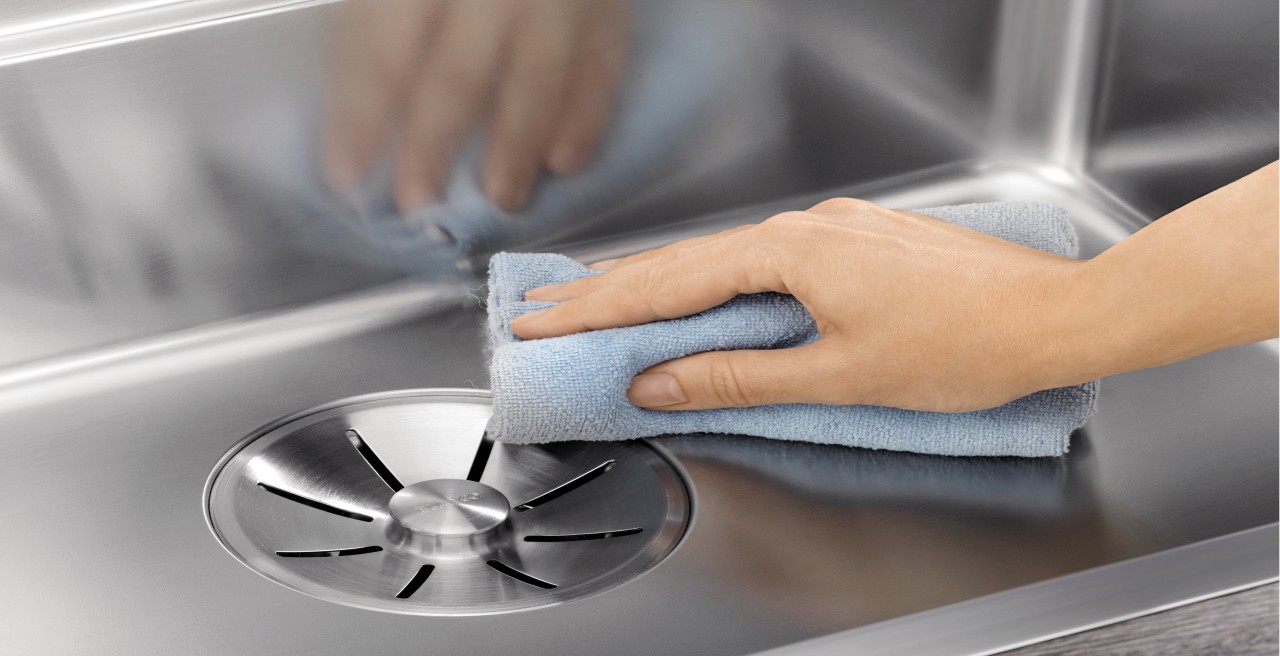The kitchen sink is one of the most used areas in the home, frequently coming into contact with food, chemicals and a variety of liquids, so it is important to maintain hygiene. All sink materials require ongoing care to ensure they are safe and bacteria free, even if they contain anti-bacterial qualities. For example, our SILGRANIT® PuraDur® sinks are coated with a Hygiene+Plus antibacterial shield, however some user maintenance is still required to ensure lasting quality and safety.
Follow our top 5 tips to keep your kitchen sink fresh and gleaming…
1. Prevent lime scale with a microfibre cloth
White lime spots only occur when water droplets evaporate and leave calcium carbonate (lime) behind. Simply wiping over your sink with a dry microfibre cloth after each use will prevent this from happening. It may sound simple but with minimal effort your sink can continue to look ‘brand new’ after years of heavy use.
2. Live in a hard water area? Choose lighter colours
‘Hard water’ contains an appreciable quantity of dissolved minerals (like calcium carbonate) and is often the cause of lime scale. It is therefore advisable to use lighter colours in areas that will frequently come into contact with water.
Stainless steel, ceramic and composite sinks in neutral colour tones make excellent choices for kitchens in hard water areas and by following our general care tips, can be protected from the effects of lime scale with simple maintenance.
3. Clean using powdered dishwasher detergent a couple of times a week
Our favourite sink cleaning technique couldn’t be simpler and takes just a couple of minutes! Follow this tried and tested method to keep your kitchen sink clean and fresh…
Ingredients:
250ml of hot water
1 teaspoon powdered dishwasher detergent
Washing up brush
Optional - rubber gloves
Method:
1. Heat 250ml of water in the kettle until boiling.
2. Allow the boiling water to cool until no simmering noises are heard.
3. Place a level teaspoon of a powdered dishwasher detergent into the sink (make sure the plug is in).
4. Pour over the hot water and allow to act for 30 seconds.
5. Use the washing up brush to clean the bowl and work the solution over the rest of the sink.
6. Open the plughole, drain any remaining cleaning solution (remove the strainer if your sink has one).
7. Now use the brush to clean the plughole area.
8. Put the strainer back into the drain and rinse the entire sink area with cold water.
9. Using a microfibre cloth, dry any water residue.
Please note: people with sensitive skin should wear rubber gloves during the process.
4. Already suffering with lime scale? Don’t panic – it CAN be removed!
Kitchen fittings like taps usually have a brass or stainless steel body and can be sensitive to abrasive cleaning and harsh chemicals. A mild acid (like lemon juice or vinegar) is more than capable of removing deposits – however the acid needs to stay in contact with the affected surface for long enough to have the desired effect.
To clean the tap spout:
Take a small plastic cup of lemon juice/vinegar and submerge the spout. Wrap the cup and spout in cling film to hold everything in place and leave for a couple of hours. Alternatively, cut a lemon in half and twist over the spout to keep it in place. After soaking, the lime scale limescale deposits should wipe away.
To clean areas surrounding the tap/drain:
Take cotton wool balls and soak them in lemon juice/vinegar, applying them to the affected areas. If you can wrap the area, or apply a weight to keep the cotton in direct contact with the area, you will achieve better results.
For badly affected areas it is important that you do not use scouring creams or rough sponges. Instead, repeat the lemon juice/vinegar process and use a plastic dish washing brush to loosen stubborn deposits.
5. Don’t just care for the visible areas of your sink
Cleaning the visible areas of your kitchen sink will likely form part of your daily routine, but it’s important to remember the harder to reach places too – like the drain. To reduce fatty deposits and any built up debris, simply pour 350g of baking soda followed by 350ml of vinegar down the drain. Put the plug in and leave the solution to sit for 30 minutes. After this time, pour a kettle of hot water into the drain and then run cool water for a minute or so.
Discover more about BLANCO’s kitchen sink range and how to choose the perfect sink for your kitchen.
